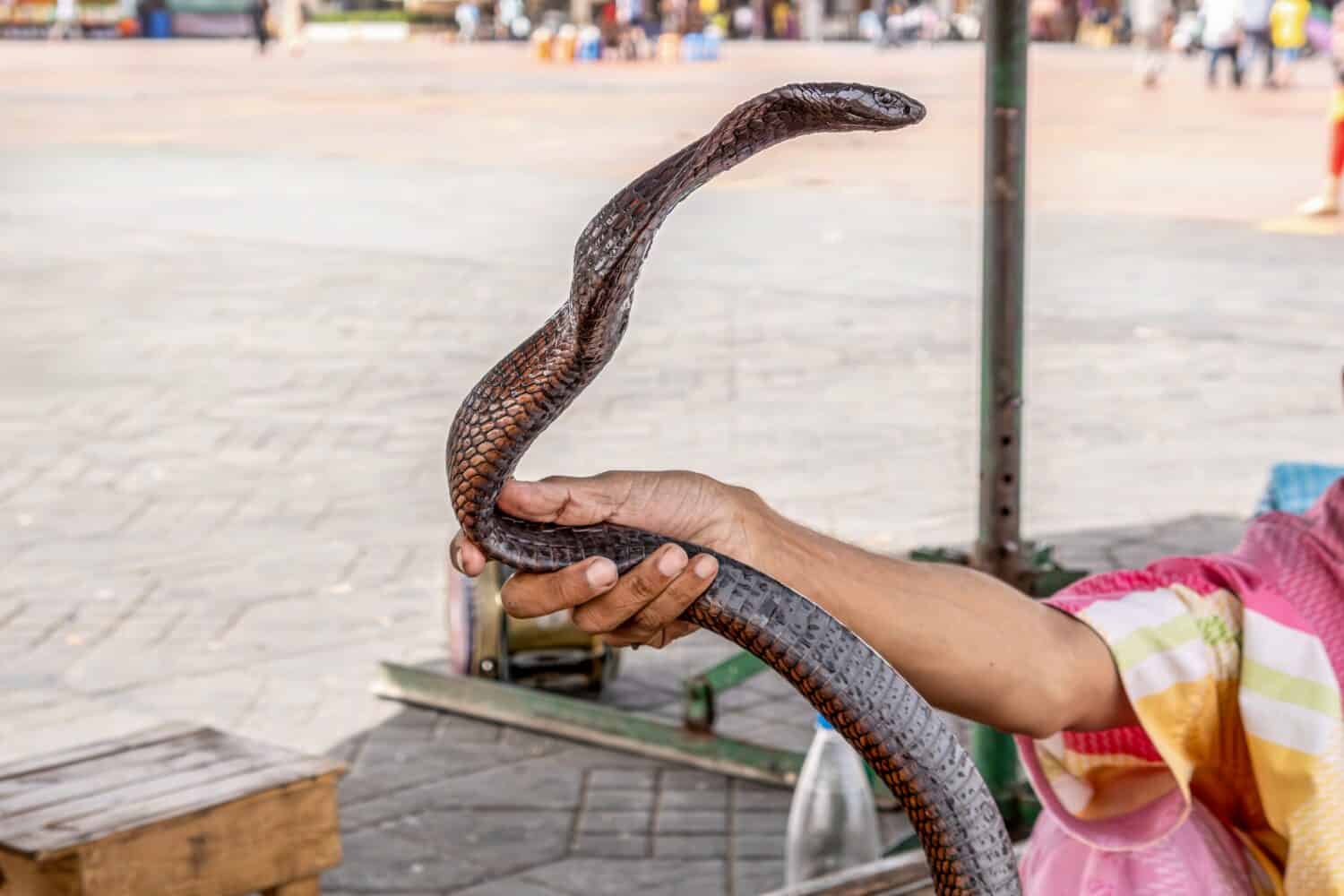Some jobs just don’t pay like they used to — including, apparently, snake charming. Recently four snake charmers traveling on the Chambal Express train in the Indian state of Uttar Pradesh released their live snakes into the train compartment after a performance. When they did not collect the amount of money they wanted to earn, they decided to retaliate by scaring their fellow passengers. Chaos ensued.
What Happened?
According to a passenger quoted by the Indiatimes News, Dherraj Kumar, who comes from the Mahoba district of India, the snake charmers came on board the train at the Banda station and got off about an hour later at Mahoba. Apparently hoping to make some money from a performance, the four snake charmers played flute music and played flute music as a snake moved back in forth in time with the music.

Snake charmers in India, disappointed in the pay they received for a performance, released live snakes in a train car.
©Joe Ravi/Shutterstock.com
Disappointed by their Pay
When the performance concluded, the snake charmers asked the train passengers for money. While some passengers did pay up, others chose not to — leading to an exchange between the passengers and the snake charmers.
Deciding to Create Panic
Shortly after this argument, the snake charmers released their animal performers out of the lidded basket that contained the reptiles. The result was pandemonium, as passengers scrambled to hide or move to the higher level of the train compartment. Amid the chaos in the train compartment, one of the passengers contacted the railway control room of the Government Railway Police at Mahoba station. After about 30 minutes, the train did reach Mahoba station. There, the snake charmers collected their snakes and got off the train. Thankfully, nobody was injured and the snakes did not bite anyone anyone, although the experience was distressing for some.
Have the snake charmers been identified or caught?
As of September 12, the snake charmers have not been caught. However, authorities are working to identify the four culprits.
What are snake charmers?
Snake charming is an Indian folk art in which a person attempts to control a snake through hypnotism. Snake charmers typically use a flute-like instrument called a “pungi.” Since snakes are associated with evil and have a respected status in Hindu mythology, the act of charming reptile shows the power and importance of the snake charmer in the face of the snake.
Traditionally, charmers have used the Indian cobra, Burmese pythons, or even mangrove snakes. They release the snakes from a basket or other container and play music. They perform for onlookers and attempt to make the snakes “dance” or sway in time to the music’s rhythm.

Snake charmers attempt to “tame” or “hypnotize” snakes by playing music on an instrument.
©Dmitry Kalinovsky/Shutterstock.com
How common are snake charmers in India?
Though India is sometimes called “the land of snake charmers,” this inherited practice and profession is dying out. Though snake charmers used to be a key part of Indian festivals and appear commonly at street markets and in tourist areas, Indian law made it illegal to keep snakes. Additionally, snake charming was banned in India in 1991. As a result, this folk practice seems to be declining. While animal rights activists say this is a good thing, others mourn the loss of this distinctively Indian tradition.
Can snakes hear music?
While snake charmers traditionally make snakes “dance” to the melodies from a flute-like musical instrument, snakes cannot actually hear the music. Snakes do not have ears! Though they can absorb vibrations from sound, this is not quite the same as hearing a snake charmer’s musical notes. If that is the case, what causes the snake to sway with the sound from a snake charmer’s instrument? In fact, this is the result of the snake fixing its focus on the performer’s moving flute or pipe. This creates an illusion that the snake is moving to the music. In reality, it is actually just tracking the movement of a swaying object that might appear like a threat.

Snakes do not hear a snake charmer’s music but actually sway from side to side as they track the movement of the pipe or flute.
©Crok Photography/Shutterstock.com
Why do animal rights activists oppose snake charming?
Despite being a traditional Indian folk art, many animal rights advocates oppose snake charming. These activists describe it as a practice based on animal cruelty. In fact, to keep highly dangerous and venomous snakes from biting, snake charmers may harm the creatures. They reduce the risk of their own injury by breaking the snakes’ fangs or sewing their mouths closed. Without a way to eat prey, these snakes slowly starve. However, some snake charmers protest. They say that they simply “tame” their snakes. They also argue that they may actually be part of protecting snakes – by keeping them rather than killing them. As a result, some snake charmers insist it is important to continue practicing their tradition.

Many animal rights activists say that snake charming involves animal cruelty.
©Annabell Gsoedl/Shutterstock.com
The photo featured at the top of this post is © kagemusha/Shutterstock.com
Discover the "Monster" Snake 5X Bigger than an Anaconda
Every day A-Z Animals sends out some of the most incredible facts in the world from our free newsletter. Want to discover the 10 most beautiful snakes in the world, a "snake island" where you're never more than 3 feet from danger, or a "monster" snake 5X larger than an anaconda? Then sign up right now and you'll start receiving our daily newsletter absolutely free.
Thank you for reading! Have some feedback for us? Contact the AZ Animals editorial team.







